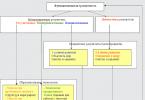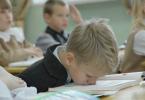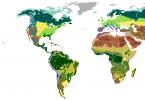Presentation for the vocal lesson
"Singing Voice"
vocal music teacher GBOU secondary school No. 8 "Music" Frunzensky district St. Petersburg E. V. Matsyshina Cover note for the presentation
"Singing Voice"
One of the leading directions of development modern society is general informatization. First of all, it affects the field of education. Currently the majority educational institutions are well equipped technically, which makes it possible for the teaching staff to widely use the capabilities of a computer in their work in various fields of education, even in such a “practical” discipline as VOCAL.
I work in general education school With in-depth study disciplines of the musical cycle. This is a specialized school, the specificity of which is the synthesis of general education and music cycles. In our school, musical disciplines are taught both in group and in individual forms (musical instrument, vocals).
This presentation is a multimedia tool used on initial stage learning to sing within the subject "vocal".
relevance of this presentation.
The singer's instrument is his organism! It is often very difficult to explain in words the work of internal muscles and organs. Therefore, the language of vocal teachers is always very figurative. Often in vocal lessons you can hear such expressions: “Imagine that we are pushing the piano or lifting a heavy bucket” (an attempt to activate the work of the abdominal muscles with association and habitual sensation), “Send sound into space” (send sound to the resonator), “Feeling the dome” (raised position of the palate), etc. All these comparisons, associations do not always help to achieve the desired result, since the sensations of all people are different. Therefore, vocal teachers are always looking for ways to more clearly display the process of the body's work during singing (this is a personal show, and an appeal to posters, dummies, video, audio recordings, etc.). As a result of such searches, this presentation appeared. Novelty.
Despite the wide range available visual material, there are no special licensed presentations recommended for use in vocal lessons. Each teacher in the classroom uses visual material at his discretion. The author of this presentation took advantage of the capabilities of a modern computer (program Microsoft PowerPoint ) and databases of Internet resources, methodological literature for collecting, summarizing, systematizing material. As a result, it became possible to present theoretical material on the subject of "vocal" more VISUALLY, colorfully and interestingly.
Description of the software product:
Name: "Singing voice".
Brief theses:
This presentation was created using Microsoft PowerPoint 2007, databases of Internet resources, methodological literature on the methodology of teaching vocals, the work of the vocal apparatus. The collected information was summarized, systematized, and visually presented in the form of 21 slides. This presentation is structured in two parts.
1.
The first part consists of slides showing the work of internal muscles, body parts involved in the process of sound production.
2.
The second part of the presentation consists of slides aimed at getting acquainted with different types of singing voices and examples of the performance of works by outstanding performers of our time.
System requirements
: Windows 2003(2007) NT 2000/XP , Celeron,
2200MHz,320 GB,
2048 MB, free disk space, readerCDandDWDdisks,screen extension1366x768,Flash-player, mouse.
Author: music teacher in vocal class Matsyshina Elena Vladimirovna.
The subject area to which the material belongs
: This presentation is intended to be used as an additional visual material on primary lessons in the subject "Academic vocal".
Age: 11 - 12 years old (first year of study)
Type of: a demonstration tool in the form of a series of slides with images, text material and accompanying sound bites.
Purpose of using this presentation
:
A visual representation of the work of the singer's body while singing; expanding students' knowledge on the issue of "singing voice".
Tasks:
1) Explanation of the basic principles of singing.
- the concept of "singing" breathing;
- the work of the vocal cords during singing;
- focusing, resonating and roundness of sound;
- freedom of the "singing apparatus".
2)
Demonstration of the internal work of the singer's body while singing.
3) Expanding the horizons of students:
- development of vocal terminology;
- deepening knowledge about the "physiology" of the singing process;
- accumulation of auditory experience.
The content of the presentation:
Slide 1. Name of the project. Author data.
Slide 2. Computer technology
Slide 3. Part 1. title
Slide 4. The structure of the vocal apparatus
Slide 5. The main components of the mechanism of sound production in the process of singing
Slide 6. "Singing breath"
Slide 7. Vocal cords
Slide 8. Resonators
Slide 9. The concept of "Vocal position"
Slide 10. The influence of the main components of the sound formation process on sound quality
Slide 11. Part 2. title
Slide 12. Classification of singing voices
Slide 13. Basic singing ranges
Slide 14. Soprano
Slide 15. Mezzo-soprano
Slide 16. Tenor
Slide 17. Baritone
Slide 18. Bass
Slide 19. Conclusions
Literature:
1. 1.
Dmitriev L.B. Fundamentals of vocal technique. M.: Muzyka, 1996. 367p.
2. 2.
Dmitriev L.B. Singer's voice apparatus // visual aid, - M., 2004.
3. 3.
Ovchinnikova T.N. On the issue of education
children's singing
votes in progress
work with the choir.//Musical education at school. Issue. 10.- M., 1975, p. . 17-23.
4. 4.
OrlovaN.D. On the singing working range of schoolchildren. In the book: Musical education at school - M .: Music, 1975, issue 10, pp. 19-95.
5. 5.
Stulova G.P. The development of a child's voice in the process of singing - M., Muzyka, 1992, 270 pages.
6. 6.
slide 3
The breathing apparatus is:
a) lungs, which are inflatable air reservoirs
b) Airways- bronchi and trachea, i.e. windpipe;
c) diaphragm - a muscle that separates the chest cavity from the abdominal cavity and is attached partly to the lower ribs, partly to the spine.
Also involved in respiration are:
d) abdominal muscles that exert pressure on the diaphragm during exhalation and
e) intercostal muscles of the chest, from the contraction of some of which the chest is compressed, from the contraction of others - expansion and inspiration.
slide 4
Diaphragm
At rest (during exhalation), the diaphragm rises upward with a two-headed dome, when inhaling it flattens, lowers, and the lungs fill with air. The ability to control the diaphragm is very important for singers. Thanks to its activity, professional vocalists have such characteristics as breath support, singing vibrato, etc.
slide 5
Larynx
- The larynx is a tube that connects the trachea to the pharynx.
- It occupies the front of the neck.
- The larynx is made up of 5 cartilages and muscles.
- The external muscles of the larynx raise, lower or fix the larynx.
- These properties of the larynx are very important especially for opera singers.
slide 6
Bundles
By clicking on the "Download archive" button, you will download the file you need for free.
Before downloading this file, remember those good essays, control, term papers, theses, articles and other documents that are unclaimed on your computer. This is your work, it should participate in the development of society and benefit people. Find these works and send them to the knowledge base.
We and all students, graduate students, young scientists who use the knowledge base in their studies and work will be very grateful to you.
To download an archive with a document, enter a five-digit number in the field below and click the "Download archive" button
Similar Documents
The role of breathing in human life. Respiratory organs: nasal cavity, larynx, trachea, bronchi, lungs. The structure of the human nasal cavity. Right and left lungs. Structure of bronchioles and alveoli. Gas exchange in the lungs and tissues. The role of oxygen in the life of the cell.
presentation, added 01/11/2010
Formation and development of voice in children. Physiology of the voice in children. Diseases of the organs of the vocal apparatus, their prevention. Hygiene and protection of the voice of children. Measures for the hygiene of the voice of children. Rules for maintaining the health of the vocal apparatus.
abstract, added 11/15/2008
Essence and functions of respiration. External and internal breathing. The transport of oxygen from lungs to tissues and carbon dioxide from tissues to lungs. Upper and lower respiratory (air-carrying) tracts. The structure of the larynx, nasal cavity, trachea. Sound formation.
presentation, added 02/16/2012
Creators of the cell theory. Features of archaea and cyanobacteria. Phylogeny of living organisms. The structure of a eukaryotic cell. Mobility and fluidity of membranes. Functions of the Golgi apparatus. Symbiotic theory of the origin of semi-autonomous organelles.
presentation, added 04/14/2014
The cell theory of Schleiden and Schwann. composition of viruses. Methods for studying cells. The structure and functions of its surface apparatus, membrane, epimembrane complex, chromoplasts, leukoplasts, ribosomes, organelles, nucleus, nuclear envelope, karyoplasm, chromosomes.
presentation, added 11/13/2014
History of the development of the physiology of digestion. Characteristics of digestion and nutrients. The structure and function of the digestive apparatus. Digestion in the mouth and swallowing, in the stomach, in the small intestine. The structure of the liver and biliary apparatus.
abstract, added 10/21/2013
The structure of the pelvis is the part of the human skeleton located at the base of the spine. Transverse measurements of the pelvis. The relationship of the shape and size of the pelvis with its function. Iliopsoas, obturator internus, piriformis muscles. The structure of the female pelvis.
presentation, added 03/18/2015
Presentation objectives: To consider the human speech apparatus in his narrow
and in a broad sense, its structure;
To trace the process of formation of speech sounds;
Highlight the functions of individual sections and organs,
involved in the formation of sounds
speech.
Each sound of speech is not only a physical phenomenon, but also a physiological one, since the CNR is involved in its formation and perception. With fiziol
Each sound of speech is a phenomenon not onlyphysical, but also physiological, because in
his education and perception involved
CNR. From a physiological point of view, speech
appears as one of its functions. It is generally accepted that the immediate
source of speech sounds
a stream of air expelled from the lungs through
bronchi, trachea and oral cavity outward.
Therefore, the speech apparatus is considered in
narrow and broad sense.
In a broad sense, the speech apparatus includes:
Central nervous system(CNR);Organs of hearing (and vision - for written
speech) necessary for the perception of sounds;
Speech organs necessary for production
sounds.
In a narrow sense, the speech apparatus is the organs of speech, consisting of:
Respiratory organs;Larynx;
epiglottal organs;
supraglottic cavities.
Respiratory organs are:
Lungs;Bronchi;
Windpipe
(trachea).
Larynx (larynx) -
upper
extended part
trachea. Here
located
voice apparatus.
The vocal apparatus consists of cartilage and muscles. Its backbone is formed by the cricoid and thyroid cartilages. The cricoid cartilage is connected to the trachea
The vocal apparatus consists of cartilage and muscles. Histhe skeleton is formed by the cricoid and thyroid cartilages.
The cricoid cartilage is connected to the trachea and is
base of the larynx. The vocal cords are elastic
able to stretch and shorten. The process of creating speech sounds begins with
that the air pumped by respiratory
organs, passes through the glottis and
makes the vocal cords tremble. Under
vibrations produce sounds
a certain frequency.
The upper floor of the speech apparatus
conclusions
The speech apparatus in a broad sense includes the CNR,organs of perception and organs of speech, in the narrow
considered as a system of speech organs;
The fundamental basis of any speech sound is nervous
momentum out speech centers brain and jet
air from the lungs that enters through the vocal
gap, and then moves through the larynx and
supraglottic cavities;
Respiratory organs produce air
vocal cords under its pressure create sounds
a certain frequency. Organs in the mouth
cavities, already form the sound finally
Tatiana Pavlova
Speech therapy lesson "Acquaintance with the organs of articulation"
Acquaintance with the organs of articulation apparatus and concept "sound" and letter.
Target: To form in children an initial idea of the speech apparatus and introduce organs of articulation.
Tasks:
1) Correctional - educational:
Fixing with children the names of parts of the face and articulatory organs;
Introducing children to basic articulation exercises, developing basic movements and positions organs of articulation;
Elimination of insufficiency in the development of speech motor skills (working out preparatory articulatory exercises for development organs of articulation);
Introducing children to the concept"speech sounds"
2) Correctional - developing:
Develop phonemic awareness through play "Clap your hands";
Develop coordination of movements through a physical minute;
3) Correctional - educational:
Develop the ability to behave properly classes;
Cultivate interest in occupation, benevolent attitude towards each other.
Equipment: didactic manual "Clown Tongue", intended for analysis articulation of sounds.
Lesson progress
1. Organizing time.
Hello guys, my name is... I'm a teacher- speech therapist.
Today we start our first speech therapy lesson.
Now look at these faces (I show the pictograms to the children)
How different they are! (children name emotions on pictures) .
Depict the evil Baba Yaga, the good wizard, the sad Alyonushka, upset Ivan Tsarevich. Take a mirror, it will help you.
Do you know what you need speech therapist How does he help children?
Who has a speech? What is speech for?
2. Post subject. The development of auditory attention.
Today we will listen, recognize, pronounce different sounds.
Close your eyes. One, two, three, four, five - we begin to be silent and calmly listen to the sounds.
Held "silent game".
What did you hear? Try to name the source of the sound? Where is he from?
Man is surrounded by many sounds.
The game "Learn by sounds" (on the table are objects made of glass, wood, paper, iron). These sounds come from the action with various subjects. These are non-verbal sounds.
What were you listening to? (Ears).
Ears are important organ of our body. What should be done to preserve our hearing and not harm it? (you can not shout loudly to each other, and put small objects in your ears, close your ears in cold weather).
4. Acquaintance with the term speech sound.
The game "Onomatopoeia".
No, these sounds are also non-speech, they are just animal voices, onomatopoeia.
And we, people, speak, a person has speech, we pronounce the sounds of speech, the sounds are combined into syllables, syllables into words, words into phrases and sentences.
And now for comparison let's say: a-a-a-a, o-o-o-o, sh-sh-sh-, r-r-r-r. We made speech sounds.
Why does a person need speech?
Speech is necessary in order to communicate, to transfer life experience, knowledge. This is how teachers and parents pass on their knowledge and experience to you, and you communicate with each other, understand each other.
5. Acquaintance with the organs of articulation.
Tell me what bodies take part in the formation of sounds, words.
That's right, we pronounce sounds with our mouths. Our mouth is a house of sounds.
In this house
red beasts,
Next to the doors
White animals.
love animals
Sweets and buns
This house has a door and not even one (work in front of mirrors):
The first door is the lips, the second is the teeth.
Make a sound (P). This sound is pronounced with the lips.
Make a sound (l). See how our tongue pressed against our teeth. The house has a sky ceiling. Click like horses, lift the tongue by the upper teeth, you feel the tubercles - these are the alveoli.
Put your palms on the neck and make a sound (e)-a voice lives here sometimes it sleeps and you can’t hear it, make a sound (With).
Organs that participate in the formation of sounds can be called in one word - articulation apparatus.
Now let's look at the diagram articulatory machine and call it parts:
Cheeks, lips, teeth, tongue, jaws, palate everything bodies are in the oral region. As well as the pharynx and larynx.
6. Articulation gymnastics.
To pronounce sounds beautifully, you need to teach your lips, teeth and tongue to perform different exercises: "Needle", "Shovel", "Swing"…
Well done guys, remind me what time of year it is? That's right, autumn, despite the fact that there is snow on the street, we are still autumn, more precisely, the last month of autumn is November.
Let's rest a little, got up 7. Physical Minute.
We are autumn leaves hands up, swaying movements left and right; They sat on the branches to sit down, waving their hands; A breeze blew - stand up, wave your arms forward; And we flew. light waving of the hands;
They flew, they flew. light waving of the hands;
And they sat quietly on the ground. sit down slowly.
8. Breathing exercises.
In order to beautifully pronounce sounds, it is necessary not only to perform exercises for the tongue, but also to learn the correct speech breathing. The back is straight, inhale through the nose, smooth, slow exhale through the nose ( "We blow on the leaves").
9. The concept of sounds. Characteristics of sounds.
Today we talk a lot about sounds, but what are sounds?
Describe the sounds of vowels and consonants.
Working with chips and diagrams.
10. Sound analysis words.
Now lay out the chips word: bow, wasp, moon.
11. The concept of a letter.
Guys, remember that we pronounce and hear sounds, and we write and see letters. Each letter has its own name. For example sound (l) a, letter e, etc.
12. Lay out the letter from the strings.
But first we need to do exercises for the fingers. "Swallow" (using tissue paper).
Guys what did we do today lesson? Did you like it occupation? What tasks did you find interesting? What task was the most difficult? Guys, you did a very good job, well done.




